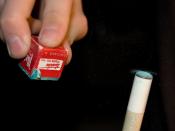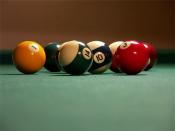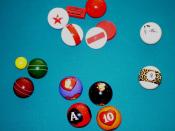The game of pool may not be as relaxing as one may think. Rather than just aimlessly hitting the cue ball around a table covered in felt, there is a set of law governing the outcome of play. These laws are known as PHYSICS. Billiards is played by striking the cue ball with a cue stick. The cue ball then collides with the other balls on the table in hopes of propelling one or more balls (preferably not the cue ball) into one of the six pockets. Based on the type, angle, and momentum of the collision, the ball will respond accordingly. A general rule of thumb for this game of angles is momentum = mass x velocity. The momentum of the cue ball before it strikes another ball will always be equal to the momentum of the cue ball and whatever it strikes afterward according to the conservation of momentum. So if the cue ball is moving quickly, there is a good chance the ball it hits will also move quickly; and just the opposite if the cue ball has a small velocity, or speed. Since momentum is a vector quantity, it describes both magnitude and direction. To truly conserve momentum, the direction of the balls resulting from the collision must also cancel out with the direction of the cue ball. The get a ball to go exactly where you want it, just calculate the angle desired, and strike the cue ball with the appropriate velocity. Who said physicists weren't up for sports?
More Physics
essays:
The Physics of Scuba Diving
... sport. The scenery is magnificent and the sensations are truly indescribable. Today, scuba diving is quickly becoming one of the expanding trades. Whether for military, research, business, or recreation, hundreds of thousands of ... . The most important rule in scuba diving ... we see, hear and move about in ...
"Outline of Physics" Book I, Chapter 1, including section review questions.
... x 10-9 s. - Kilogram (mass) / mass of 0.001 cubic meters of water / the mass of ... , following the rules for significant figures. a) 26 x 0.02584 = b) 15. ... moving at any speed, including very high speeds - particle collisions, particle accelerators, nuclear energy - Quantum mechanics - behavior of ...
Outline of Chapter 1 of High School Physics Book-Includes study guide questions.
... x 10-9 s. - Kilogram (mass) / mass of 0.001 cubic meters of water / the mass of ...
One application of magnetic fields in household appliances.
... , microwave ovens, and other small household appliances. In this motor, small single-turn copper "shading coils" create the moving magnetic field. Part of each pole is encircled by a copper coil or strap; the induced current in the strap opposes the change ...
The Chaos Theory
... change in the balls path. However, with each ball it collides with, the ball strays farther and ... weeks from now because of this dynamic.'(Lorenz, 1987) The general rule for complex systems ... support this move to interdisciplinary research. Complexity is already affecting many aspects of our lives ...


